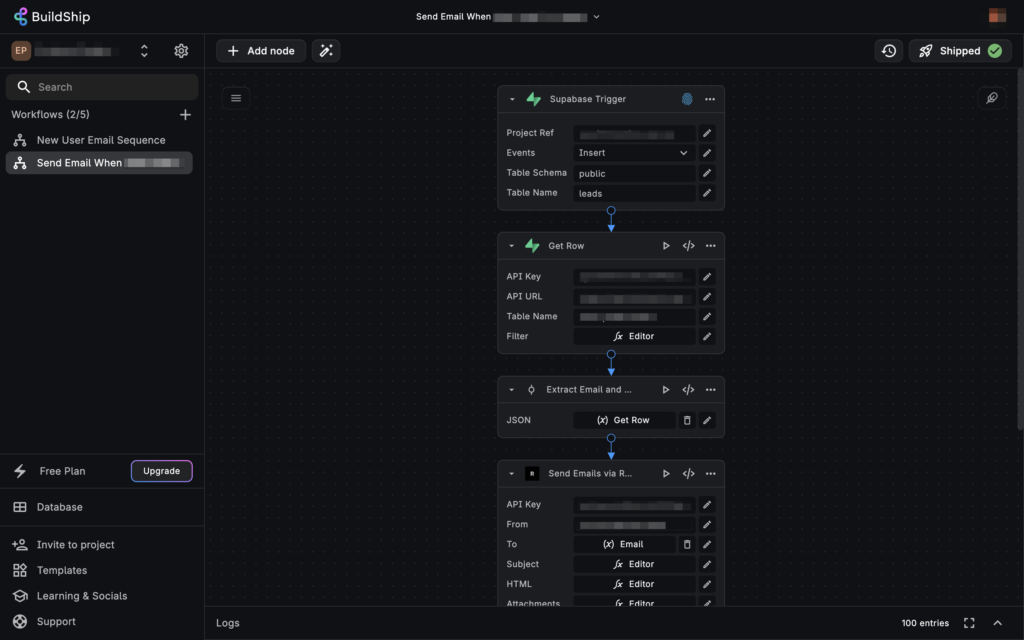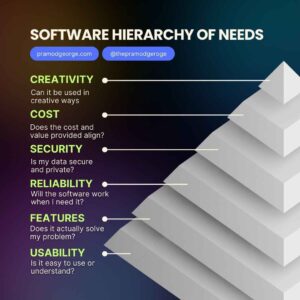In 2023, I built and launched Evallo.app and Anntho.com and I did it all using low code tools. I love Low-code tools because they democratise software development. Since July 2023, I’ve been testing and reviewing most of the low code apps out there – and I think I found the best ones.
Choosing the best tools came down to asking 4 questions.
Question 1: Does the platform allow code export?
The beauty of low code tools is their ability to speed up your go-to-market time. But, in case your product takes off – you may want to scale by exporting your code – to customise it and/ or run it on your own hosting services. That’s why it’s important to check if your no-code platform offers code-exports.
For example, bubble.io, the most famous low-code platform helps you create web-apps at lightning speeds. But, it doesn’t allow you to export code. Yes, you could build a multi-million dollar app using bubble.io, but you’re locked into their platform. But luckily, today, we have a new breed of visual low code developers that allow you to, not just build SAAS fast but also export your code.
Another related question you can ask is whether the platform is built on a well known code language kit? The answer to this may automatically tell you if your platform offers code exports.
For example, Flutterflow and plasmic.com, built on flutter and react respectively. Flutter and React are free open-source software development kits (SDK). Because these low code apps are built using these free SDKs – they also allow code export. This saves you tons of re-work when you grow.
Code export is another way of asking “Do you own your code?”. Ownership means I can take my business where I want.
Much like owning a wordpress website vs a wix.com or framer.com website. You can host and expand your wordpress’s website anywhere you want. But when you create a website using wix.com or framer.com, it can only exist in their proprietary environments.
Question #2: Does it have an active community?
An active community is a sign of a healthy and growing low code platform. It represents the founder’s commitment to the growth of the platform.
If the product doesn’t have an active community – no matter how good the product is. You will not succeed. Why? Because when you run into problems, you won’t have anyone who knows the tool well enough to help you.
For example, plasmic.com is an excellent tool. It is probably the best platform to help you build web apps. Its features and pricing blow every other competitor out of the water. Unfortunately their community is dead. Even the founders are not active on their own community. I tried replicating evallo.com using plasmic for two weeks – but I had to give up. Despite plasmic being an excellent tool, the lack of community made it difficult for me to build anything of value using the platform.
So avoid tools that lack a vibrant community.
Question #3: Does it have AI assistant integrated?
The only way that non-technical folks can leverage low code tools is if AI is integrated into it.
Remember low-code doesn’t mean no-code. You will eventually run into scenarios where only code can solve your problems. That’s where AI comes in. AI helped me write complex queries to get specific data from my database. AI helped me write code to solve CORS issues. AI helped me write code to extract user AUTH data from JWTokens.
For example. When I used fastgen to build Anntho.com. It didn’t have an AI assistant or co-pilot. So whenever I needed to code. I had to leverage chatgpt. I manually explained my app, gave the AI context and asked questions – all in a single monstrous thread. Today many alternative solutions, like for example buildship.com has integrated AI. This makes writing code right within the app easy.
Question #4: Does it offer parity pricing?
This is not a must have – but it’s a good to have offer.
Most low-code tools focus on selling to the developed world. But the pricing for the USA is not feasible to users in developing countries like India.
Parity pricing is a feature that offers a discount to the user based on their location. It’s also how the product shows that it’s ready for a huge user base. Choosing products that offer parity pricing means choosing products that are committed to scale and growth.
Best Low Code Tools For 2024
Now that you understand how to select tools, let me tell you ‘my’ favourite tools. Luckily for most intents and purposes, there are only 3 tools you need.
1. A tool to create your frontend (UI).
2. A tool to create your backend.
3. A tool to connect your app with external tools.
Ready? Let’s go…
Flutterflow for your FrontEnd
Flutterflow allows users to visually build native mobile and web applications. It’s built on top of Flutter, a free open source SDK by Google. It enables quick iteration and provides the option to view and export clean Flutter code. Flutter code is famous for being cross-platform. This means that you only need to create code once and Flutter makes it run on Apple, Android and Web devices flawlessly. Flutterflow enables rapid app development and deployment, making it a valuable tool for both beginners and experienced developers. It has the biggest community of all the other platforms. They also have some of the best training videos in the industry.

Flutterflow is best suited for mobile apps. They are still working on improving the web-app capabilities. But anytime that you notice a feature missing – you can code it yourself with the help of AI. Alternatively, you can check out pub.dev. Pub.dev is the official package manager for the Dart programming language, providing a repository of reusable libraries and packages for Flutter. They were also one of the first low-code platforms to offer parity pricing.
Click here to check out Flutterflow
Supabase for your backend
Supabase is a Firebase backend alternative and does everything (authentication, database, storage, functions just to name a few) while being open sourced and having an awesome and generous FREE tier. It is user friendly and built on postgress. So if you have a basic knowledge of SQL, you’ll figure out how to leverage this platform easily. Even if you don’t have a basic understanding of SQL, since SQL is one od the oldest ways to query data, AI does a fanstastic job writing SQL queries, commands, funcationa etc, so you’ll never have to worry. I use this tool knowing that if ever need to scale, I can simply spin up my own instance of Supabase on my own server and move quickly without hassle. If you’re not using Supabase as your backend for your SAAS, you’re making a mistake.

Buildship for integration or automation
This tool is still in beta at the time of writing this post, but it is already better than most other similar tools in the market. Buildship is an integration tool. It’s technical description is a a low-code API and workflow builder. In plain english, that just means that helps you connect your frontend and backend services to other other services.
For example, connect your stripe account to Supabase – When a user pays using stripe, you can create an integration/ workflow to update a Supabase table automatically.

Another way to think of an integration tool is to think of it as an automator. When event A happens, perform B.
If you’re one of the founders of these tools – Kudos for the great work.
Honourable Mentions
I want to offer special mentions to Plasmic, Weweb and builder.io who are all great tools to create web-apps. However, this article is focussed on helping the little guy, the non-technical guy build and launch apps without much fuss. These tools are probably better suited to developers who want to speed up their development. A different market completely.

